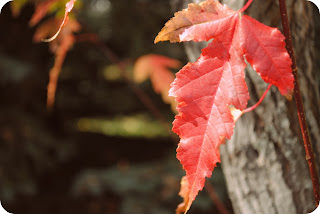Yesterday was the first day of Fall. Happy Belated Autumnal Equinox everybody!
 Fall is one of the most beautiful seasons to be in Canada... The weather is perfect for cozy sweaters and scarves without requiring you stuff the feathers of an entire goose into your jacket to keep warm.
Fall is one of the most beautiful seasons to be in Canada... The weather is perfect for cozy sweaters and scarves without requiring you stuff the feathers of an entire goose into your jacket to keep warm. (Rather, this is typical fall weather. The weather is pretty cooking hot right now...)
My friends who live in other climates insist on calling the season "Autumn" (Australians... sheesh...) but I continue to explain that we call it "Fall" since that's what the leaves do. (The fact that it helps us remember how Daylight Savings Time works is just a bonus...)
There is not enough light in the winter time for trees to continue to photosynthesize, so trees go into a kind of hibernation, when they live off the sugars they produced during the summer. When the days begin to shorten, the tree will reabsorb valuable nutrients and compounds from its leaves, and store them in the trunk. Leaves are fragile structures, and are dropped for the winter. (This allows the tree to get rid of wastes, save energy, and deter pests.)
Chlorophyll is continually made by the plant all summer - when the days shorten and the tree starts preparing for winter, it stops replenishing its supply of the green pigment and the color fades. The other pigments that were present all summer can now be seen: yellow comes from a compound called xanthophyll, and orange is due to carotenoids.
Some plants will start to produce a different pigment at the end of the growing season, anthocyanin, which causes leaves to appear red. Brown leaves result when all the pigment in the leaves degrades, leaving only the cell walls behind.
 |
| Check out the anthocyanin in this Japanese Maple! |
So get out there, put on your favorite fall sweater (or continue wearing your short shorts, as the weather allows) and enjoy the beautiful colors put on display by Mother Nature!
(And when they are no longer as stunning to look at... I hope you enjoy crunching them as much as I do!)
(And when they are no longer as stunning to look at... I hope you enjoy crunching them as much as I do!)

No comments:
Post a Comment